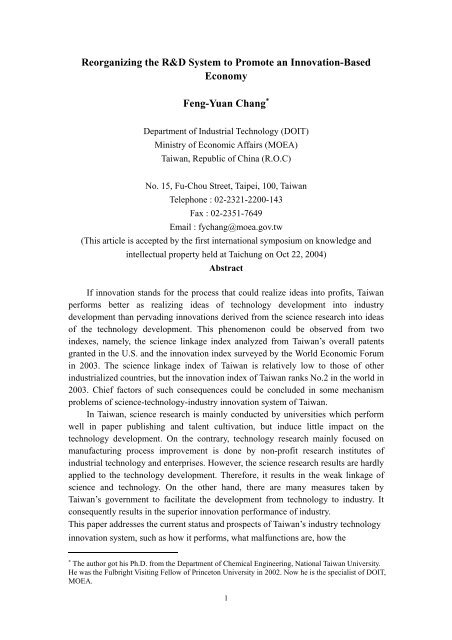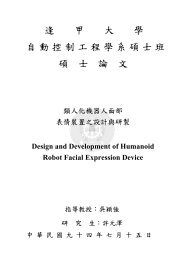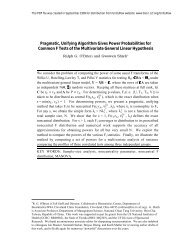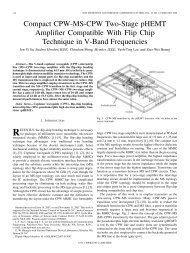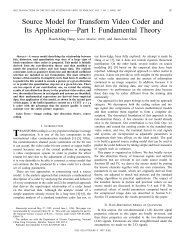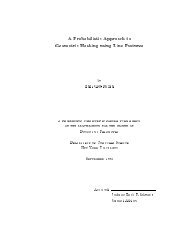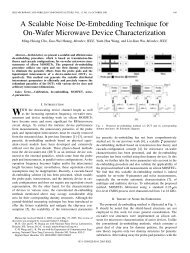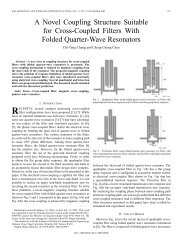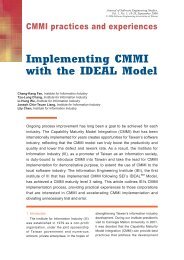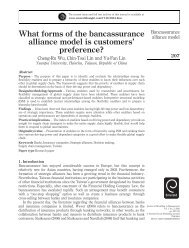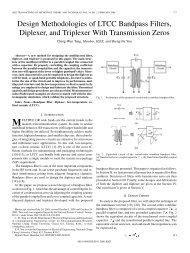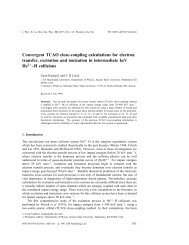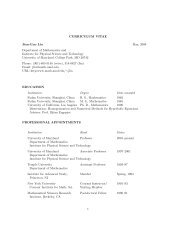Reorganizing the R&D System to Promote an Innovation-Based ...
Reorganizing the R&D System to Promote an Innovation-Based ...
Reorganizing the R&D System to Promote an Innovation-Based ...
Create successful ePaper yourself
Turn your PDF publications into a flip-book with our unique Google optimized e-Paper software.
<strong>Reorg<strong>an</strong>izing</strong> <strong>the</strong> R&D <strong>System</strong> <strong>to</strong> <strong>Promote</strong> <strong>an</strong> <strong>Innovation</strong>-<strong>Based</strong><br />
Economy<br />
Feng-Yu<strong>an</strong> Ch<strong>an</strong>g ∗<br />
Department of Industrial Technology (DOIT)<br />
Ministry of Economic Affairs (MOEA)<br />
Taiw<strong>an</strong>, Republic of China (R.O.C)<br />
No. 15, Fu-Chou Street, Taipei, 100, Taiw<strong>an</strong><br />
Telephone : 02-2321-2200-143<br />
Fax : 02-2351-7649<br />
Email : fych<strong>an</strong>g@moea.gov.tw<br />
(This article is accepted by <strong>the</strong> first international symposium on knowledge <strong>an</strong>d<br />
intellectual property held at Taichung on Oct 22, 2004)<br />
Abstract<br />
If innovation st<strong>an</strong>ds for <strong>the</strong> process that could realize ideas in<strong>to</strong> profits, Taiw<strong>an</strong><br />
performs better as realizing ideas of technology development in<strong>to</strong> industry<br />
development th<strong>an</strong> pervading innovations derived from <strong>the</strong> science research in<strong>to</strong> ideas<br />
of <strong>the</strong> technology development. This phenomenon could be observed from two<br />
indexes, namely, <strong>the</strong> science linkage index <strong>an</strong>alyzed from Taiw<strong>an</strong>’s overall patents<br />
gr<strong>an</strong>ted in <strong>the</strong> U.S. <strong>an</strong>d <strong>the</strong> innovation index surveyed by <strong>the</strong> World Economic Forum<br />
in 2003. The science linkage index of Taiw<strong>an</strong> is relatively low <strong>to</strong> those of o<strong>the</strong>r<br />
industrialized countries, but <strong>the</strong> innovation index of Taiw<strong>an</strong> r<strong>an</strong>ks No.2 in <strong>the</strong> world in<br />
2003. Chief fac<strong>to</strong>rs of such consequences could be concluded in some mech<strong>an</strong>ism<br />
problems of science-technology-industry innovation system of Taiw<strong>an</strong>.<br />
In Taiw<strong>an</strong>, science research is mainly conducted by universities which perform<br />
well in paper publishing <strong>an</strong>d talent cultivation, but induce little impact on <strong>the</strong><br />
technology development. On <strong>the</strong> contrary, technology research mainly focused on<br />
m<strong>an</strong>ufacturing process improvement is done by non-profit research institutes of<br />
industrial technology <strong>an</strong>d enterprises. However, <strong>the</strong> science research results are hardly<br />
applied <strong>to</strong> <strong>the</strong> technology development. Therefore, it results in <strong>the</strong> weak linkage of<br />
science <strong>an</strong>d technology. On <strong>the</strong> o<strong>the</strong>r h<strong>an</strong>d, <strong>the</strong>re are m<strong>an</strong>y measures taken by<br />
Taiw<strong>an</strong>’s government <strong>to</strong> facilitate <strong>the</strong> development from technology <strong>to</strong> industry. It<br />
consequently results in <strong>the</strong> superior innovation perform<strong>an</strong>ce of industry.<br />
This paper addresses <strong>the</strong> current status <strong>an</strong>d prospects of Taiw<strong>an</strong>’s industry technology<br />
innovation system, such as how it performs, what malfunctions are, how <strong>the</strong><br />
∗ The author got his Ph.D. from <strong>the</strong> Department of Chemical Engineering, National Taiw<strong>an</strong> University.<br />
He was <strong>the</strong> Fulbright Visiting Fellow of Prince<strong>to</strong>n University in 2002. Now he is <strong>the</strong> specialist of DOIT,<br />
MOEA.<br />
1
government takes actions <strong>to</strong> improve its efficiency with <strong>the</strong> partnership of private<br />
sec<strong>to</strong>r.<br />
Keywords: R&D, <strong>Innovation</strong>-based Economy, Industrial Technology<br />
1. Introduction<br />
If innovation st<strong>an</strong>ds for <strong>the</strong> process that could realize ideas in<strong>to</strong> profits, Taiw<strong>an</strong><br />
performs better as realizing ideas of technology development (D) in<strong>to</strong> industry<br />
development th<strong>an</strong> pervading innovations derived from <strong>the</strong> science research (R) in<strong>to</strong><br />
ideas of <strong>the</strong> technology development. This phenomenon could be observed from two<br />
indexes, namely, <strong>the</strong> science linkage index <strong>an</strong>alyzed from Taiw<strong>an</strong>’s overall patents<br />
gr<strong>an</strong>ted in <strong>the</strong> U.S. <strong>an</strong>d <strong>the</strong> innovation index surveyed by <strong>the</strong> World Economic Forum<br />
(WEF) in 2003. The science linkage index of Taiw<strong>an</strong> is relatively low <strong>to</strong> those of<br />
o<strong>the</strong>r industrialized countries, but <strong>the</strong> innovation index of Taiw<strong>an</strong> r<strong>an</strong>ks No.2 in <strong>the</strong><br />
world. Chief fac<strong>to</strong>rs of such consequences could be concluded in some mech<strong>an</strong>ism<br />
problems for interactions of science research <strong>an</strong>d technology development.<br />
In Taiw<strong>an</strong>, science research is mainly conducted by universities which perform<br />
well in paper publishing <strong>an</strong>d talent cultivation, but induce little impact on <strong>the</strong><br />
technology development. On <strong>the</strong> contrary, technology research mainly focused on<br />
m<strong>an</strong>ufacturing process improvement is done by non-profit research institutes of<br />
industrial technology as well as enterprises. However, <strong>the</strong> science research results are<br />
hardly applied <strong>to</strong> <strong>the</strong> technology development. Therefore, it results in <strong>the</strong> weak<br />
linkage of science research <strong>an</strong>d technology development. To tighten <strong>the</strong> linkage, <strong>the</strong>re<br />
are m<strong>an</strong>y measures taken by Taiw<strong>an</strong>’s government <strong>to</strong> facilitate <strong>the</strong> development from<br />
technology <strong>to</strong> industry so as <strong>to</strong> better innovation perform<strong>an</strong>ce of industry.<br />
This paper addresses <strong>the</strong> current status <strong>an</strong>d prospects of Taiw<strong>an</strong>’s industry<br />
technology R&D system, such as how it performs, what malfunctions are, how <strong>the</strong><br />
government takes actions <strong>to</strong> improve its efficiency.<br />
2. Taiw<strong>an</strong> is a premier m<strong>an</strong>ufacturing center in <strong>the</strong> world<br />
Around 1970, Taiw<strong>an</strong>’s economic development was based on labor-intensive<br />
light industries. Textiles, Plastics <strong>an</strong>d Appli<strong>an</strong>ces soared <strong>an</strong>d played key roles in <strong>the</strong><br />
world’s markets. Taiw<strong>an</strong>’s bal<strong>an</strong>ce of trade turned from a deficit <strong>to</strong> a surplus.<br />
During that time, Taiw<strong>an</strong>’s economic development was fiercely affected by <strong>the</strong><br />
oil crisis because local industrial development had <strong>the</strong> strong dependency with oil<br />
supply. In order <strong>to</strong> tr<strong>an</strong>sform structure of local industry from labor-intense <strong>to</strong><br />
technology-intense, which was highly decisive <strong>to</strong> hum<strong>an</strong> brains <strong>an</strong>d less correlated <strong>to</strong><br />
natural resources, Taiw<strong>an</strong>’s government decided <strong>to</strong> set up <strong>the</strong> first industrial<br />
technology research institute, ITRI, in 1973. Missions of ITRI are assigned <strong>to</strong> develop<br />
industrial technologies <strong>an</strong>d tr<strong>an</strong>sfer <strong>the</strong>m <strong>to</strong> industry, which is composed mainly of<br />
small <strong>an</strong>d medium sized enterprises.<br />
2
ITRI tr<strong>an</strong>sferred high technologies from abroad <strong>to</strong> Taiw<strong>an</strong>, which were suitable<br />
<strong>to</strong> develop locally, <strong>an</strong>d continued <strong>to</strong> add value. Combining talent <strong>an</strong>d capital<br />
investment, new comp<strong>an</strong>y spin-offs from ITRI blossomed in<strong>to</strong> new industries. For<br />
inst<strong>an</strong>ce, United M<strong>an</strong>ufacturing Comp<strong>an</strong>y (UMC) was spun off from ITRI in 1980.<br />
UMC became <strong>the</strong> 2nd largest IC foundry in <strong>the</strong> world in terms of production.<br />
Taiw<strong>an</strong> Semiconduc<strong>to</strong>r M<strong>an</strong>ufacturing Comp<strong>an</strong>y (TSMC) was spun off from ITRI in<br />
1986. TSMC also became <strong>the</strong> largest IC foundry comp<strong>an</strong>y in <strong>the</strong> world in terms of<br />
production as well.<br />
Following <strong>the</strong> spin-offs, IC foundry, IC packaging, IC design etc., completely<br />
new industries, developed one after <strong>an</strong>o<strong>the</strong>r. The number of comp<strong>an</strong>ies for each<br />
industry is illustrated in Table 1 in 2002. Me<strong>an</strong>while, Personal Computers,<br />
Op<strong>to</strong>electronics, Telecom <strong>an</strong>d so on all followed <strong>the</strong> same development path.<br />
3
Table 1 Number of comp<strong>an</strong>ies for IC industry in Taiw<strong>an</strong> in 2002<br />
Design Mask Foundry Package Test Chemicals Lead<br />
Frame<br />
Number of<br />
Comp<strong>an</strong>ies<br />
180<br />
(+40)<br />
4 15<br />
(-1)<br />
45<br />
(-3)<br />
36<br />
(-1)<br />
19<br />
(-1)<br />
4<br />
Source: Project of Industrial Technology Intelligence Services (ITIS), DOIT, MOEA,<br />
2003, (+/-): increasing/decreasing number of comp<strong>an</strong>ies in comparison with those of<br />
2001.<br />
In step with ITRI’s growth, Taiw<strong>an</strong> has become a premier world m<strong>an</strong>ufacturing<br />
center over <strong>the</strong> last 30 years. Taiw<strong>an</strong> was <strong>the</strong> 4th largest information technology (IT)<br />
hardware production country in <strong>the</strong> world in 2003, which was after <strong>the</strong> U.S., China<br />
<strong>an</strong>d Jap<strong>an</strong>. Fur<strong>the</strong>rmore, Taiw<strong>an</strong>’s comp<strong>an</strong>ies made up 72.9% of China’s IT<br />
production. Taiw<strong>an</strong> was also <strong>the</strong> 4th largest semi-conduc<strong>to</strong>r production country in <strong>the</strong><br />
world in 2003, which was after <strong>the</strong> U.S., Jap<strong>an</strong> <strong>an</strong>d South Korea. In addition, Taiw<strong>an</strong><br />
was <strong>the</strong> 2nd largest thin film tr<strong>an</strong>sister - liquid crystal display (TFT-LCD) production<br />
country in <strong>the</strong> world in 2003, which was after South Korea <strong>an</strong>d outpaced Jap<strong>an</strong>. The<br />
market penetration of <strong>the</strong> above three industries is shown in Table 2. M<strong>an</strong>y of<br />
Taiw<strong>an</strong>’s products were Number 1 in world market share in 2003 as demonstrated in<br />
Table 3.<br />
Table 2 The market penetration of Taiw<strong>an</strong>’s high-tech industries in 2003<br />
(percentage of market penetration)<br />
R<strong>an</strong>k 1st R<strong>an</strong>k 2nd R<strong>an</strong>k 3 rd R<strong>an</strong>k 4 th<br />
IT hardware<br />
production<br />
US(28.2%) China(22.2%) Jap<strong>an</strong>(10.1%) Taiw<strong>an</strong>(5.4%)<br />
Semi-conduc<strong>to</strong>r<br />
Production<br />
TFT-LCD<br />
Production<br />
Source: ITIS, DOIT, MOEA, 2004<br />
US(51%) Jap<strong>an</strong>(25.6%) S. Korea(8%) Taiw<strong>an</strong>(7.8%)<br />
S. Korea(46.3%) Taiw<strong>an</strong>(34.5%) Jap<strong>an</strong>(19.2%) -<br />
With <strong>the</strong> establishment of m<strong>an</strong>ufacturing capabilities, Taiw<strong>an</strong> gradually builds up<br />
pro<strong>to</strong>type of science <strong>an</strong>d technology development infrastructure. According <strong>to</strong> “The<br />
World Competitiveness Yearbook 2004” issued by <strong>the</strong> International Institute for<br />
M<strong>an</strong>agement Development (IMD), among nations with a population over 20 million,<br />
Taiw<strong>an</strong> became No. 5 in <strong>the</strong> index of science infrastructure, which was after USA,<br />
Jap<strong>an</strong>, Germ<strong>an</strong>y <strong>an</strong>d Fr<strong>an</strong>ce. In addition, Taiw<strong>an</strong> r<strong>an</strong>ked No. 6 in <strong>the</strong> index of<br />
4
technology infrastructure, which was after USA, C<strong>an</strong>ada, Australia, Germ<strong>an</strong>y <strong>an</strong>d<br />
Malaysia. Fur<strong>the</strong>rmore, according <strong>to</strong> “2003 The Global Competitiveness Report”<br />
issued by WEF, Taiw<strong>an</strong> became No. 3 in technology index, which was after <strong>the</strong> U.S.<br />
<strong>an</strong>d Finl<strong>an</strong>d. Taiw<strong>an</strong> r<strong>an</strong>ked No. 2 in innovation sub-index, which was after USA.<br />
Table 3 World No. 1 products in terms of market shares/volumes of Taiw<strong>an</strong> in 2003<br />
IC<br />
Market shares/Production World Penetration<br />
Foundry US$8,349M 65.8%<br />
Mask ROM US$271M 89.7%<br />
IC Packaging US$2,650M 27.9%<br />
Computer & Peripheral Devices<br />
CD-R Disk 5923.8M Pcs 64%<br />
CD-RW Disk 228.23M Pcs 84%<br />
DVD-R Disk 517.9M Pcs 75%<br />
DVD-RW Disk 73.02M Pcs 62%<br />
Networking Products<br />
ADSL Modem 14M Sets 59%<br />
Wireless LAN 39.4M Sets 78%<br />
Analog Modem 9,018K Sets 25%<br />
SOHO Router 6,491K Sets 35%<br />
O<strong>the</strong>r<br />
ABS Resin 1530K M.T. 24.3%<br />
Source: ITIS, DOIT, MOEA, 2004, unit: B:Billion, M:Million, K:Thous<strong>an</strong>d,<br />
M.T.:Metric Ton, Pcs : pieces<br />
3. Major challenges for <strong>the</strong> innovation-based economy<br />
It’s noted that Taiw<strong>an</strong>’s industry is superior <strong>to</strong> product adjustment <strong>an</strong>d process<br />
improvement. It thus results that Taiw<strong>an</strong>’s economy falls in<strong>to</strong> <strong>the</strong> “incremental<br />
innovation-based economy”. In order <strong>to</strong> tr<strong>an</strong>sform such <strong>an</strong> economy in<strong>to</strong> “radical<br />
innovation-based economy” so as <strong>to</strong> get new momentum <strong>to</strong> push for economic growth,<br />
Taiw<strong>an</strong>’s 2003 Science <strong>an</strong>d Technology Meeting of <strong>the</strong> Executive Yu<strong>an</strong> concluded that<br />
implementation of “innovation-based economy” was a very desirable next step for<br />
Taiw<strong>an</strong> <strong>to</strong> take. Following this policy, <strong>the</strong> industry technology R&D would evolve<br />
from a system based on “incremental innovation” <strong>to</strong> <strong>the</strong> one based on “radical<br />
innovation”.<br />
However, in a bid <strong>to</strong> promote <strong>the</strong> development of “innovation-based economy”<br />
dem<strong>an</strong>ds a comprehensive system. Major innovation activities in Taiw<strong>an</strong>’s<br />
m<strong>an</strong>ufacturing industry (electronics or non-electronics) fell within categories such as<br />
products, technology <strong>an</strong>d m<strong>an</strong>ufacturing processes. <strong>Innovation</strong>s in org<strong>an</strong>ization,<br />
5
m<strong>an</strong>agement <strong>an</strong>d marketing recorded only a small portion as observed in Table 4 <strong>an</strong>d<br />
Table 5.<br />
Table 4 Categories of innovations for m<strong>an</strong>ufacturing industry of Taiw<strong>an</strong> in 2003<br />
M<strong>an</strong>ufacturing Products Technology M<strong>an</strong>ufacturing Org<strong>an</strong>izational Marketing<br />
Industry<br />
Process M<strong>an</strong>agement<br />
Electronics 49% 33% 15% 0% 3%<br />
Non-electronics 34% 30% 17% 9% 10%<br />
Source: Conference materials of 2003 Science <strong>an</strong>d Technology Meeting of <strong>the</strong><br />
Executive Yu<strong>an</strong>, R.O.C, investigated by Industrial Economics <strong>an</strong>d Knowledge Center<br />
(IEK), ITRI<br />
Table 5 Categories of <strong>Innovation</strong>s for Service Industry of Taiw<strong>an</strong> in 2003<br />
Contents<br />
of Services<br />
Procedures of<br />
Service Providing<br />
Org<strong>an</strong>izational Marketing Cus<strong>to</strong>mizati<br />
M<strong>an</strong>agement<br />
on<br />
Service 33% 22% 15% 16% 13%<br />
Industry<br />
Source: Conference materials of 2003 Science <strong>an</strong>d Technology Meeting of <strong>the</strong><br />
Executive Yu<strong>an</strong>, R.O.C, investigated by IEK, ITRI.<br />
It should be noted that inputs of science <strong>an</strong>d technology c<strong>an</strong> be a major driving<br />
force for <strong>the</strong> innovation-based economy, but <strong>an</strong> efficient innovation network is more<br />
crucial for capitalizing on <strong>the</strong> effort made. However, current systems for science<br />
research <strong>an</strong>d technology development of Taiw<strong>an</strong> are undermined by such problems as<br />
unexploited linkages between industry <strong>an</strong>d universities. Therefore, <strong>the</strong>re is a need <strong>to</strong><br />
streng<strong>the</strong>n <strong>the</strong> structural networking interfaces in <strong>the</strong> innovation networks, especially<br />
interactions between industry <strong>an</strong>d universities.<br />
4. Current status of interactions between industry <strong>an</strong>d universities<br />
4.1 In retrospect<br />
Taiw<strong>an</strong> has been a “fast follower” in economic development. A stylized division<br />
of labor within <strong>the</strong> current innovation system could be categorized as follows.<br />
Universities carry out academic research <strong>an</strong>d training of talent. Industrial technology<br />
research institutes conduct technology introduction, value addition, <strong>an</strong>d technology<br />
diffusion. Industry is doing technology absorption <strong>an</strong>d product m<strong>an</strong>ufacturing. The<br />
development of <strong>the</strong> economy is effectively supported through efficient interactions<br />
among three groups.<br />
6
4.2 Current developments of universities<br />
Universities <strong>an</strong>d colleges in Taiw<strong>an</strong> have grown subst<strong>an</strong>tially in number from<br />
123 in 1991 <strong>to</strong> 154 in 2002. As a result of <strong>the</strong> rapid exp<strong>an</strong>sion in <strong>the</strong> high education<br />
system, nearly 70% of Ph.D. graduates are employed on campus, providing <strong>an</strong><br />
abund<strong>an</strong>t supply of adv<strong>an</strong>ced R&D personnel.<br />
Along with <strong>the</strong> growth of adv<strong>an</strong>ced R&D talents, government funded R&D<br />
expenditures at universities <strong>an</strong>d colleges have grown signific<strong>an</strong>tly since 2002 as well.<br />
Ratio of universities’ R&D expenditures funded by government hiked <strong>to</strong> 84.75% in<br />
2001, whereas funded by industry reduced <strong>to</strong> 3.23%, relatively low compared with<br />
those of <strong>the</strong> U.S., UK <strong>an</strong>d South Korea as compared in Table 7.<br />
Table 7 University R&D budget from private sec<strong>to</strong>r Unit:%<br />
1991 1997 1998 1999 2000 2001<br />
USA 5.30 6.00 6.10 6.20 6.00 5.70<br />
C<strong>an</strong>ada 7.00 9.80 9.40 9.10 9.60 9.60<br />
Germ<strong>an</strong>y 7.00 9.70 10.50 11.30 11.60 11.30<br />
UK 7.80 7.10 7.30 7.30 7.10 6.20<br />
Jap<strong>an</strong> 2.40 2.40 2.30 2.30 2.50 2.30<br />
Finl<strong>an</strong>d 3.60 5.20 4.50 4.70 5.60 6.70<br />
Sweden 5.20 4.80 - 3.90 - 5.50<br />
South Korea - 14.90 13.10 10.80 15.90 14.30<br />
Taiw<strong>an</strong>-Private Sec<strong>to</strong>r - - 3.03 4.75 4.13 3.23<br />
Taiw<strong>an</strong>-Public Sec<strong>to</strong>r - - 88.33 85.80 85.10 84.75<br />
Source: Survey <strong>an</strong>d Analysis of Innovative Competitiveness of Knowledge<br />
Economics Project, DOIT, MOEA, 2003<br />
As regards R&D perform<strong>an</strong>ce of universities indicated in terms of paper<br />
publications in 2001, Taiw<strong>an</strong> r<strong>an</strong>ked <strong>the</strong> 18th in <strong>the</strong> world in <strong>the</strong> number of<br />
published papers, accounting for 1.1% of <strong>the</strong> world’s <strong>to</strong>tal paper publications as<br />
shown in Table 8. For <strong>the</strong> number of papers published in <strong>the</strong> database of Science<br />
Citation Index(SCI), Taiw<strong>an</strong> r<strong>an</strong>ked 17th with 10,635 papers published in 2001. The<br />
average frequency for Taiw<strong>an</strong>’s papers being cited is 2.71 over <strong>the</strong> 1995-2001 period,<br />
lower th<strong>an</strong> those of Jap<strong>an</strong> <strong>an</strong>d Singapore but higher th<strong>an</strong> those of South Korea <strong>an</strong>d<br />
China. In 2001, 55.5% of Taiw<strong>an</strong>’s papers published in databases of SCI, Social<br />
Science Index (SCI) <strong>an</strong>d Engineering Index (EI) were contributed by National Taiw<strong>an</strong><br />
University (NTU), National Tsing Hwa University (NTHU), National Chiao Tung<br />
University, National Cheng Kung University (NCKU), <strong>an</strong>d National Central<br />
University (NCU).<br />
7
Table 8 World r<strong>an</strong>king <strong>an</strong>d share of academic papers out of selected countries<br />
unit:%<br />
1996 1997 1998 1999 2000 2001<br />
R<strong>an</strong>king Share R<strong>an</strong>king Share R<strong>an</strong>king Share R<strong>an</strong>king Share R<strong>an</strong>king Share R<strong>an</strong>king Share<br />
USA 1 31.3 1 30.5 1 29.3 1 28.6 1 28.0 1 27.9<br />
UK 2 8.5 2 8.1 2 8.1 2 8.1 2 8.2 2 7.8<br />
Jap<strong>an</strong> 3 7.5 3 7.5 3 7.7 3 7.8 3 7.7 3 7.7<br />
Germ<strong>an</strong>y 4 6.8 4 7.0 4 7.3 4 7.1 4 7.1 4 7.1<br />
Fr<strong>an</strong>ce 5 5.3 5 5.3 5 5.4 5 5.3 5 5.2 5 5.1<br />
China 14 1.6 12 1.9 12 2.1 9 2.5 8 3.1 8 3.4<br />
Ne<strong>the</strong>rl<strong>an</strong>ds 10 2.2 11 2.2 11 2.2 12 2.1 12 2.1 12 2.1<br />
S. Korea 20 0.9 18 1.0 16 1.2 16 1.3 16 1.4 15 1.6<br />
Taiw<strong>an</strong> 19 0.9 19 0.9 19 1.0 20 1.0 20 1.0 18 1.1<br />
Israel 17 1.1 16 1.1 18 1.1 18 1.0 19 1.0 21 1.0<br />
Singapore 40 0.2 37 0.3 36 0.3 36 0.3 34 0.4 34 0.4<br />
Source : Survey <strong>an</strong>d Analysis of Innovative Competitiveness of Knowledge Economics Project, DOIT,<br />
MOEA, 2003<br />
In respect of patents secured by <strong>the</strong> higher education institutes, <strong>the</strong> number of<br />
patents accumulated by universities <strong>an</strong>d colleges with 10 patents <strong>an</strong>d above is 1,936<br />
through September, 2003. The <strong>to</strong>p 4 universities accounted for more th<strong>an</strong> 60% of <strong>the</strong><br />
<strong>to</strong>tal patent gr<strong>an</strong>ts <strong>to</strong> academia as shown in Table 9.<br />
Although academic patents represent better scientific linkages <strong>to</strong> industry,<br />
Taiw<strong>an</strong>’s academic patenting is relatively less th<strong>an</strong> paper publications, causing<br />
concerns about <strong>the</strong> present weak linkage between science research <strong>an</strong>d industrial<br />
technology.<br />
8
Table 9 Patents gr<strong>an</strong>ted <strong>to</strong> selected higher education institutes (through September 2003)<br />
With <strong>the</strong> name of<br />
With <strong>the</strong> name of Total<br />
National Science Council<br />
School<br />
University Taiw<strong>an</strong> USA Jap<strong>an</strong> o<strong>the</strong>rs Total Taiw<strong>an</strong> USA Mixed %<br />
Total 1,098 582 88 48 1,816 108 12 1,936 100.00<br />
National Cheng 193 113 9 1 316 25 4 345 17.82<br />
Kung Univ.<br />
National Taiw<strong>an</strong> 186 113 12 8 319 10 1 330 17.05<br />
Univ<br />
National Chiao 168 79 10 10 267 13 0 280 14.46<br />
Tung Univ.<br />
National Tsing 126 76 21 19 242 19 7 268 13.84<br />
Hwa Univ.<br />
Source : Survey <strong>an</strong>d Analysis of Innovative Competitiveness of Knowledge Economics Project, DOIT,<br />
MOEA, 2003<br />
4.3 Current developments of industry<br />
As regards current developments of industry, th<strong>an</strong>ks <strong>to</strong> a vertically-disintegrated<br />
but horizontally well-integrated <strong>an</strong>d well-org<strong>an</strong>ized production system, Taiw<strong>an</strong> is able<br />
<strong>to</strong> play a key role in <strong>the</strong> global production network. The m<strong>an</strong>ufacturing sec<strong>to</strong>r is<br />
internationally competitive with capabilities regarding <strong>to</strong> original design m<strong>an</strong>ufacture<br />
(ODM) <strong>an</strong>d even integrated device m<strong>an</strong>ufacturer (IDM), such as capabilities in <strong>the</strong><br />
design <strong>an</strong>d m<strong>an</strong>ufacture of parts <strong>an</strong>d components for au<strong>to</strong>mobiles, yacht <strong>an</strong>d mo<strong>to</strong>r<br />
boats, <strong>the</strong> textile <strong>an</strong>d footwear industry, software design (e.g. <strong>an</strong>ti-virus software)<br />
<strong>an</strong>d so on. With capabilities of innovation, collaborative design, synchronous<br />
engineering, quality m<strong>an</strong>agement, <strong>an</strong>d cost control, <strong>the</strong> high-tech industry in Taiw<strong>an</strong><br />
has enjoyed competitive adv<strong>an</strong>tages in <strong>the</strong> global supply chain. For example, <strong>the</strong><br />
speed of order processing has been improved <strong>to</strong> <strong>the</strong> 982 st<strong>an</strong>dard, 98% shipment<br />
delivered within 2 days of receiving overseas orders.<br />
Recalled that industrial technology research institutes <strong>an</strong>d industry have worked<br />
closely <strong>to</strong>ge<strong>the</strong>r, industrial technology development <strong>an</strong>d industry development are<br />
highly correlated with each o<strong>the</strong>r. Taiw<strong>an</strong>’s innovation thus comes mainly from <strong>the</strong><br />
partnerships of two parties. This result could be observed from patenting competence<br />
of Taiw<strong>an</strong>’s industry.<br />
The <strong>an</strong>nual number of overall patents <strong>an</strong>d utility patents gr<strong>an</strong>ted in <strong>the</strong> U.S. <strong>to</strong><br />
Taiw<strong>an</strong> has r<strong>an</strong>ked 4th since 2000, as demonstrated in Table10 <strong>an</strong>d Table 11. The<br />
<strong>an</strong>nual overall patent productivity, <strong>the</strong> ratio of number of patents divided by million of<br />
people, <strong>an</strong>d utility patent productivity gr<strong>an</strong>ted in <strong>the</strong> U.S. has r<strong>an</strong>ked 2 nd <strong>an</strong>d 3rd<br />
9
espectively since 2000, as shown in Table 12 <strong>an</strong>d Table 13.<br />
Most of <strong>the</strong> innovative R&D investments for import<strong>an</strong>t <strong>an</strong>d newly-emerging<br />
industrial technologies in Taiw<strong>an</strong> were related <strong>to</strong> <strong>the</strong> m<strong>an</strong>ufacturing process of<br />
semi-conduc<strong>to</strong>rs. From 1999 <strong>to</strong> 2003, <strong>the</strong> number of semi-conduc<strong>to</strong>r device<br />
technology related patents gr<strong>an</strong>ted in <strong>the</strong> U.S. r<strong>an</strong>ked 3 rd , as demonstrated in Table 14.<br />
Qualities of those patents are valued by a higher frequency of citations of Taiw<strong>an</strong>ese<br />
patents in <strong>the</strong> U.S. as shown in Table 15.<br />
Table 10 Number of Taiw<strong>an</strong>’s overall patents gr<strong>an</strong>ted in <strong>the</strong> U.S. in 2003<br />
R<strong>an</strong>k Number Percentage(%)<br />
USA 1 96,938 52.71<br />
Jap<strong>an</strong> 2 37,276 19.92<br />
Germ<strong>an</strong>y 3 12,141 6.49<br />
Taiw<strong>an</strong> 4 6,679 3.57<br />
South Korea 5 4,131 2.21<br />
Source : Survey <strong>an</strong>d Analysis of Innovative Competitiveness of Knowledge<br />
Economics Project, DOIT, MOEA, 2004<br />
Table 11 Number of Taiw<strong>an</strong>’s utility patents gr<strong>an</strong>ted in <strong>the</strong> U.S. in 2003<br />
R<strong>an</strong>k Number Percentage(%)<br />
USA 1 87,938 52.00<br />
Jap<strong>an</strong> 2 35,543 21.02<br />
Germ<strong>an</strong>y 3 11,444 6.77<br />
Taiw<strong>an</strong> 4 5,300 3.13<br />
South Korea 5 3,943 2.33<br />
Source : Survey <strong>an</strong>d Analysis of Innovative Competitiveness of Knowledge<br />
Economics Project, DOIT, MOEA, 2004<br />
Table 12 Taiw<strong>an</strong>’s overall patent productivity in <strong>the</strong> U.S. in 2003<br />
R<strong>an</strong>k<br />
Number/million people<br />
USA 1 339<br />
Taiw<strong>an</strong> 2 297<br />
Jap<strong>an</strong> 3 292<br />
South Korea 14 87<br />
Source : Survey <strong>an</strong>d Analysis of Innovative Competitiveness of Knowledge<br />
Economics Project, DOIT, MOEA, 2004<br />
10
Table 13 Taiw<strong>an</strong>’s utility patent productivity in <strong>the</strong> U.S. in 2003<br />
R<strong>an</strong>k<br />
Number/million people<br />
USA 1 302<br />
Jap<strong>an</strong> 2 279<br />
Taiw<strong>an</strong> 3 236<br />
South Korea 12 83<br />
Source : Survey <strong>an</strong>d Analysis of Innovative Competitiveness of Knowledge<br />
Economics Project, DOIT, MOEA, 2004<br />
Table 14 1999-2003 Number of semi-conduc<strong>to</strong>r device patents gr<strong>an</strong>ted in <strong>the</strong> U.S.<br />
USA Jap<strong>an</strong> Taiw<strong>an</strong> South Korea<br />
R<strong>an</strong>k 1 2 3 4<br />
Number 19,123 11,989 5,281 3,040<br />
Source : Survey <strong>an</strong>d Analysis of Innovative Competitiveness of Knowledge<br />
Economics Project, DOIT, MOEA, 2004<br />
Table 15 Citations of Taiw<strong>an</strong>’s of semi-conduc<strong>to</strong>r m<strong>an</strong>ufacturing process patents<br />
gr<strong>an</strong>ted in <strong>the</strong> U.S.(unit:%)<br />
Country 1991 1995 1996 1997 1998 1999 2000 2001 1991-2001<br />
USA 40.57 49.35 44.42 45.02 41.31 41.49 42.95 44.58 43.72<br />
Taiw<strong>an</strong> 1.89 11.30 14.36 14.57 16.02 21.94 27.52 26.72 22.27<br />
Jap<strong>an</strong> 47.17 26.32 26.49 25.88 26.59 22.72 18.54 17.22 21.29<br />
S. Korea 0.00 6.99 9.41 8.94 11.69 9.04 6.89 6.97 7.93<br />
Source : Survey <strong>an</strong>d Analysis of Innovative Competitiveness of Knowledge Economics Project, DOIT,<br />
MOEA, 2003<br />
In respect of current R&D strength of industry measured by <strong>the</strong> linkage of<br />
industrial technology <strong>an</strong>d science, <strong>the</strong> average number of SCI papers cited in each<br />
utility patent of Taiw<strong>an</strong> gr<strong>an</strong>ted in <strong>the</strong> U.S. was 0.18, far behind <strong>the</strong> average of 1.97 in<br />
2001, as demonstrated in Table 16. In 2002 <strong>an</strong>d 2003, <strong>the</strong> average number of<br />
academic literature citations in each Taiw<strong>an</strong> patent gr<strong>an</strong>ted in <strong>the</strong> U.S. was 0.21 <strong>an</strong>d<br />
0.24, respectively, as illustrated in Table 17.<br />
11
Table 16 The science linkage index of Taiw<strong>an</strong>’s utility patents gr<strong>an</strong>ted in <strong>the</strong> U.S. in<br />
2000<br />
World Average USA Jap<strong>an</strong> South Korea Taiw<strong>an</strong><br />
Index 1.97 2.83 0.51 0.42 0.18<br />
Source : Survey <strong>an</strong>d Analysis of Innovative Competitiveness of Knowledge<br />
Economics Project, DOIT, MOEA, 2004<br />
Table 17 The science linkage index of Taiw<strong>an</strong>’s overall patents gr<strong>an</strong>ted in <strong>the</strong> U.S. in<br />
2002/2003<br />
USA Jap<strong>an</strong> South Korea Taiw<strong>an</strong><br />
2002 Index 4.46 0.99 0.76 0.21<br />
2003 Index 4.62 1.08 0.86 0.24<br />
Source : Survey <strong>an</strong>d Analysis of Innovative Competitiveness of Knowledge<br />
Economics Project, DOIT, MOEA, 2004<br />
Although Taiw<strong>an</strong>ese industry is good at producing patents, most of <strong>the</strong>m are<br />
related <strong>to</strong> m<strong>an</strong>ufacturing processes, with only a few of <strong>the</strong>m having originality.<br />
Taiw<strong>an</strong>’s science linkage index position is relatively low compared <strong>to</strong> o<strong>the</strong>r<br />
industrialized nations. There is a need <strong>to</strong> develop science-based patents <strong>an</strong>d<br />
science-based industries in Taiw<strong>an</strong>.<br />
In short, research universities with abund<strong>an</strong>t adv<strong>an</strong>ced R&D personnel <strong>an</strong>d<br />
sufficient funding focus mostly on paper publication. Industry presently concentrates<br />
on patenting innovative m<strong>an</strong>ufacturing process. This constitutes a potential gap of<br />
science research <strong>an</strong>d technology development.<br />
5. Lessons <strong>an</strong>d perform<strong>an</strong>ce from <strong>the</strong> promotion of <strong>the</strong> innovative industrial<br />
technology R&D<br />
In order <strong>to</strong> get rid of playing <strong>the</strong> role of “fast follower”, DOIT of MOEA made up<br />
its mind <strong>to</strong> kick off <strong>the</strong> innovative industrial technology R&D commencing in 1998,<br />
by me<strong>an</strong>s of allocating 20% of <strong>the</strong> <strong>to</strong>tal industrial technology R&D budget of<br />
DOIT-MOEA <strong>to</strong> ITRI.<br />
The properties of <strong>the</strong> innovative industrial technology are:<br />
1. The technology is yet commercialized world-widely. The technology will<br />
fur<strong>the</strong>r induce investments from both private sec<strong>to</strong>r <strong>an</strong>d public sec<strong>to</strong>r in future,<br />
12
coming up <strong>the</strong> industry expectation for yielding long-term industry<br />
development impact.<br />
2. The technology ei<strong>the</strong>r has <strong>the</strong> potential <strong>to</strong> become <strong>the</strong> leading technology of<br />
Taiw<strong>an</strong> or could make <strong>the</strong> competitiveness of Taiw<strong>an</strong>’s industry go at a good<br />
pace.<br />
3. The technology could result in new products <strong>an</strong>d new industries eventually.<br />
In general, <strong>the</strong> program aims at establishing a favorable environment for<br />
innovative industrial technology R&D for ITRI by not implementing new measures<br />
but through “deregulation” <strong>an</strong>d “institutional reform”.<br />
Deregulation reflects upon features of this program including independent project<br />
m<strong>an</strong>agement systems, budgetary au<strong>to</strong>nomy, a review mech<strong>an</strong>ism based on full<br />
communication, <strong>an</strong>d project implementation flexibility. Details could be fur<strong>the</strong>r<br />
referred <strong>to</strong> “The Innovative Industrial Technology R&D Project Self-Evaluation<br />
Report” compiled by ITRI in 2004.<br />
Institutional reform responds <strong>to</strong> a culture for innovative industrial technology<br />
research that was established gradually at ITRI. Cultural <strong>an</strong>d environmental ch<strong>an</strong>ges<br />
for industrial technology R&D program at ITRI could be signaled as follows:<br />
1.Outst<strong>an</strong>ding experts are recruited <strong>to</strong> conduct <strong>the</strong> R&D program:<br />
An adequate environment <strong>an</strong>d mech<strong>an</strong>isms have been set up <strong>to</strong> bring excellent<br />
talents <strong>to</strong> join <strong>the</strong> innovative industrial technology R&D programs at ITRI. 10<br />
experts have been invited from overseas <strong>an</strong>d Taiw<strong>an</strong> in<strong>to</strong> ITRI <strong>to</strong> lead projects.<br />
The number of researchers with Ph.D. degree involved in this program is 1.8<br />
times <strong>to</strong> that of <strong>the</strong> o<strong>the</strong>r programs sponsored by MOEA, as compared in Table<br />
18.<br />
13
Table 18 M<strong>an</strong>power employed by ITRI’s innovative industrial technology<br />
R&D program<br />
Ph.D. Master Bachelor O<strong>the</strong>rs Total<br />
2001 M<strong>an</strong>-year 151.9 257.7 48.4 35.8 493.8<br />
% 30.8% 52.2% 9.8% 7.2% 100%<br />
2002 M<strong>an</strong>-year 178.0 381.9 53.0 54.5 667.4<br />
% 26.7% 57.2% 7.9% 8.2% 100%<br />
2003 M<strong>an</strong>-year 179.0 408.8 50.0 49.7 687.5<br />
% 26.0% 59.5% 7.3% 7.2% 100%<br />
Total M<strong>an</strong>-year 508.9 1048.4 151.4 140 1,848.7<br />
% 27.5% 56.7% 8.2% 7.5% 100%<br />
The o<strong>the</strong>r MOEA supported project employed m<strong>an</strong>power<br />
2001 % 16.0% 49.3% 18.1% 16.5% 2,436<br />
2002 % 15.4% 50.2% 16.2% 18.3% 2,730<br />
2001 % 15.4% 58.3% 14.2% 12.1% 2,615<br />
Source: The Innovative Industrial Technology R&D Project Self-Evaluation<br />
Report, ITRI, 2004<br />
2.Leveraging external resources:<br />
Collaborative research with local universities of ITRI was streng<strong>the</strong>ned<br />
through <strong>the</strong> establishments of <strong>the</strong> joint R&D centers as shown in Table 19.<br />
Several overseas labora<strong>to</strong>ries have been set up with <strong>the</strong> participation of foreign<br />
universities. Liaison offices have been placed in <strong>the</strong> U.S., west Europe, Jap<strong>an</strong><br />
<strong>an</strong>d Russia <strong>to</strong> introduce technologies <strong>an</strong>d experts in<strong>to</strong> Taiw<strong>an</strong>. Industrial<br />
technology R&D alli<strong>an</strong>ces have been established with local industries.<br />
14
Table 19 Joint research centers with universities set up by ITRI<br />
Field<br />
Center<br />
Communication NTHU-ITRI Joint Research Center<br />
Micro Electric-Mech<strong>an</strong>ical NCKU-ITRI MEMS <strong>an</strong>d N<strong>an</strong>o-Technology<br />
<strong>System</strong>s (MEMS) <strong>an</strong>d Research Center<br />
N<strong>an</strong>o-Technology NTHU-ITRI Joint Research Center<br />
Op<strong>to</strong>electronics<br />
National Sun Yat-sen University(NSYSU)-ITRI<br />
Op<strong>to</strong>-Electronics R&D Center<br />
Material<br />
NTU-ITRI N<strong>an</strong>o-Technology Research Center<br />
Environmental Protection NCU-ITRI Joint Research Center<br />
<strong>an</strong>d Catalyst<br />
Biomedical Technology NTU-ITRI Biomedical Technology Research<br />
Center<br />
Source: The Innovative Industrial Technology R&D Project Self-Evaluation<br />
Report, ITRI, 2004<br />
3. Securing strategic intellectual properties:<br />
Several world-leading technologies have been developed <strong>an</strong>d strategic<br />
intellectual properties have been secured. Through 2003, 805 patents are<br />
applied <strong>an</strong>d 201 patents are secured as shown in Table 20. For every 100<br />
million New Taiw<strong>an</strong> Dollar ($NTD) research budget, <strong>the</strong> program generated<br />
average 18.3 patents more th<strong>an</strong> <strong>the</strong> o<strong>the</strong>r MOEA supported R&D projects’<br />
average 10.3 patents created.<br />
15
Table 20 Patents secured by ITRI’s innovative industrial technology R&D<br />
program<br />
Category 2001 2002 2003 Total<br />
Domestic 95 124 187 406<br />
Applied Cases Overseas 81 129 189 399<br />
Total 176 523 376 805<br />
Growth Rate 43.8% 48.6% <br />
Category 2001 2002 2003 Total<br />
Domestic 26 39 71 136<br />
Gr<strong>an</strong>ted Cases Overseas 10 31 24 65<br />
Total 36 70 95 201<br />
Growth Rate 94.4% 35.7% <br />
Source: The Innovative Industrial Technology R&D Project Self-Evaluation<br />
Report, ITRI, 2004<br />
In regard of paper yielding, 1,012 papers are generated as yet. 338 papers are<br />
published in academic journals <strong>an</strong>d 674 papers are presented in conferences,<br />
as demonstrated in Table 21. For every 100 million $NTD research budget, <strong>the</strong><br />
program generated average 6.9 papers more th<strong>an</strong> <strong>the</strong> o<strong>the</strong>r MOEA supported<br />
R&D projects’ average 2.7 papers created.<br />
Table 21 Papers published by ITRI’s innovative industrial technology R&D<br />
program<br />
Category 2001 2002 2003 Total<br />
Referred Domestic 50 82.0% 110 88.7% 101 66.0% 261 77.2%<br />
Journals Overseas 11 18.0% 14 11.3% 52 34.0% 77 22.8%<br />
Cases Sub<strong>to</strong>tal 61 124 153 338<br />
Conference<br />
Cases<br />
Total<br />
Domestic 53 48.2% 167 67.6% 206 65.0% 426 63.2%<br />
Overseas 57 51.8% 80 32.4% 111 35.0% 248 36.8%<br />
Sub<strong>to</strong>tal 110 247 317 674<br />
Domestic 103 60.2% 277 74.7% 307 65.3% 687 67.9%<br />
Overseas 68 39.8% 94 25.3% 163 34.7% 325 32.1%<br />
Sub<strong>to</strong>tal 171 371 470 1,012<br />
Source: The Innovative Industrial Technology Self-Evaluation Report, ITRI,<br />
2004<br />
16
6. Develop <strong>an</strong> innovation-based economy by reorg<strong>an</strong>izing <strong>the</strong> industrial<br />
technology R&D system<br />
To develop <strong>an</strong> innovation-based economy, <strong>the</strong> first step is <strong>to</strong> adjust <strong>the</strong> institutions<br />
<strong>an</strong>d operational mech<strong>an</strong>isms of existing industrial technology R&D system, consisting<br />
of universities, industrial technology research institutes, industry <strong>an</strong>d <strong>the</strong> government.<br />
6.1 Industry<br />
It’s import<strong>an</strong>t <strong>to</strong> note that <strong>the</strong> process of innovation starting with <strong>an</strong> idea for a new<br />
technology, product <strong>an</strong>d service may originate in a variety of areas including R&D,<br />
m<strong>an</strong>ufacturing, marketing, sales <strong>an</strong>d in org<strong>an</strong>izational infrastructure <strong>an</strong>d m<strong>an</strong>agement.<br />
The process will be complete only when <strong>the</strong>re is beneficial use by cus<strong>to</strong>mers. This<br />
implies that in general <strong>an</strong> innovation will be delivered by industry. It’s very import<strong>an</strong>t<br />
for government <strong>to</strong> provide policy incentives <strong>to</strong> streng<strong>the</strong>n innovation capabilities of<br />
industry, especially those that could gear up <strong>the</strong> innovation capabilities powered by<br />
industrial technology R&D.<br />
Policy measures in reinforcing innovation capabilities of industrial technology<br />
R&D include:<br />
1. Enh<strong>an</strong>cing industrial R&D org<strong>an</strong>izations <strong>an</strong>d functions:<br />
In order <strong>to</strong> intensify <strong>the</strong> R&D activities for industry, Taiw<strong>an</strong>’s government<br />
entices local <strong>an</strong>d overseas enterprises <strong>to</strong> establish innovative industrial<br />
technology R&D centers in Taiw<strong>an</strong> so as <strong>to</strong> enh<strong>an</strong>ce industrial R&D<br />
org<strong>an</strong>izations <strong>an</strong>d functions. 66 innovative industrial technology R&D centers<br />
have been set up by local enterprises since 2002. 22 innovative industrial<br />
technology R&D centers are established by <strong>the</strong> multinational comp<strong>an</strong>ies, as<br />
shown in Table 22.<br />
2. Streng<strong>the</strong>ning innovative industrial technology R&D:<br />
The overall budget allocation for innovation industrial technology R&D of<br />
industry have soared up for 5 years. The more innovative R&D comp<strong>an</strong>ies do,<br />
<strong>the</strong> more subsides could obtain from <strong>the</strong> government.<br />
3. Reinforcing networking between industry <strong>an</strong>d universities:<br />
Taiw<strong>an</strong>’s government encourages enterprises <strong>to</strong> form industrial technology R&D<br />
alli<strong>an</strong>ces. 45 alli<strong>an</strong>ces have been made up since 2001.<br />
17
Table 22 R&D Centers set up by multinational comp<strong>an</strong>ies in Taiw<strong>an</strong><br />
Comp<strong>an</strong>y<br />
Center<br />
1 HPUSA HP Product Development Center<br />
2 SONYJap<strong>an</strong><br />
SONY DECTDesign & Engineering Center<br />
Taiw<strong>an</strong><br />
3 SONYJap<strong>an</strong> SMCT(<strong>System</strong> in Module Center Taiw<strong>an</strong>)<br />
4 AIXTRONGerm<strong>an</strong>y M<strong>an</strong>ufacturing Oriented Research Lab<br />
5<br />
Becker Avionics<br />
Avionics Certification Skill And Key Technology<br />
Germ<strong>an</strong>y<br />
Development Center<br />
6 DellUSA Dell Taiw<strong>an</strong> Design Center<br />
7 MicrosoftUSA Microsoft Technology Center<br />
8 IBMUSA Mobile e-business R&D Center<br />
9 Pericom (USA) Adv<strong>an</strong>ced Mixed-Signal IC R&D Center<br />
10 Intel (USA) Intel <strong>Innovation</strong> Center<br />
11 IBMUSA Life Sciences Center of Excellence<br />
12 Ericsson (Sweden) ERICSSON <strong>Innovation</strong> Center<br />
13 Broadcom (USA) Network <strong>System</strong> on Chip (SoC) R&D Center<br />
14 Mo<strong>to</strong>rola (USA) Product Development Center<br />
15 Honeywell (USA) Honeywell Technical Center in Taiw<strong>an</strong><br />
16 IBM (USA) IBM xSeries Taiw<strong>an</strong> development center<br />
17 GlaxoSmithKline GSK (UK) GSK Taiw<strong>an</strong> R&D Operation Center Pl<strong>an</strong><br />
18 A<strong>to</strong>tech (Germ<strong>an</strong>y) Adv<strong>an</strong>ced Technology Center<br />
19 DuPont (USA) DuPont Taiw<strong>an</strong> Technical Center<br />
20 Alcatel (Fr<strong>an</strong>ce) Alcatel ICT Application Research Center<br />
21 AKT (USA) Asia Research & Development Center<br />
22 NEC (Jap<strong>an</strong>)<br />
NEC Innovative Product Joint Development<br />
Center for Engineering<br />
Source : DOIT, MOEA, 2004<br />
18
4. Fostering development of industrial technology R&D support <strong>an</strong>d peripheral<br />
industries:<br />
A good development of industrial technology R&D support <strong>an</strong>d peripheral<br />
industries would accelerate <strong>the</strong> time <strong>to</strong> market for developed technologies. 66<br />
cases are promoted including product design, IP m<strong>an</strong>agement, incuba<strong>to</strong>r,<br />
digital content market place, silicon IP mall <strong>an</strong>d design platform, <strong>an</strong>d contract<br />
research org<strong>an</strong>ization <strong>an</strong>d so on.<br />
6.2 Universities<br />
With <strong>the</strong> accumulation of R&D resources, universities should play <strong>the</strong> role of<br />
promotion in <strong>the</strong> development of <strong>the</strong> innovation-based economy. Universities should<br />
endeavor <strong>to</strong> increase not only paper publications but also innovative <strong>an</strong>d frontier<br />
patenting. R&D activities should take in<strong>to</strong> consideration both economic <strong>an</strong>d<br />
technological development. Universities should establish <strong>the</strong>ir professional specialties<br />
with different R&D orientations. Deregulation <strong>an</strong>d institutional reform should be<br />
continued in order <strong>to</strong> reduce restrictions on <strong>the</strong> mobility, remuneration, appraisal, <strong>an</strong>d<br />
promotion of related personnel.<br />
6.3 Industrial technology research institutes<br />
Industrial technology research institutes would be catalysts that tr<strong>an</strong>sform<br />
Taiw<strong>an</strong>’s economy in<strong>to</strong> <strong>the</strong> one based on “innovation-based economy”. It’s <strong>the</strong>refore<br />
government should increase <strong>the</strong> percentage of innovative industrial technology R&D<br />
budget. O<strong>the</strong>r th<strong>an</strong> <strong>the</strong> development of technologies, innovative industrial technology<br />
R&D should also cover <strong>the</strong> development of services. Fur<strong>the</strong>rmore, government should<br />
increase implementing institutes for innovative industrial technology R&D projects.<br />
It’s also very crucial for industrial technology research institutes <strong>to</strong> integrate industrial<br />
technology R&D across different categories among industry, universities <strong>an</strong>d research<br />
institutes. To network with <strong>the</strong> world-wide innovation fountain, it is also very<br />
import<strong>an</strong>t <strong>to</strong> encourage industrial technology research institutes <strong>to</strong> commence global<br />
communication of technology <strong>an</strong>d technical cooperation with overseas org<strong>an</strong>izations.<br />
Most import<strong>an</strong>tly, industrial technology research institutes should enforce <strong>the</strong>mselves<br />
in org<strong>an</strong>izational reinvention <strong>to</strong> stimulate originality <strong>an</strong>d creativity in <strong>the</strong><br />
org<strong>an</strong>izations.<br />
6.4 The government<br />
The government m<strong>an</strong>euvers <strong>the</strong> process of “institutional reform” <strong>an</strong>d<br />
“deregulation” for <strong>the</strong> industrial technology R&D system. It’s recommended that<br />
government convenes a meeting for cooperation between industry <strong>an</strong>d universities for<br />
19
<strong>the</strong> Ministry of Economic Affairs, Ministry of Education, <strong>an</strong>d National Science<br />
Council <strong>to</strong> discuss related regula<strong>to</strong>ry reform <strong>an</strong>d institutional ch<strong>an</strong>ge.<br />
7. Conclusions<br />
Taiw<strong>an</strong>’s government has been started reorg<strong>an</strong>izing <strong>the</strong> industrial technology R&D<br />
system <strong>to</strong> promote <strong>an</strong> innovation-based economy by improving innovation<br />
networking. The government has focused on deregulation <strong>an</strong>d institutional reform in<br />
order <strong>to</strong> provide a foundational environment <strong>to</strong> establish corresponding cultures for<br />
innovative R&D. A culture for innovative industrial technology research was<br />
established gradually inside <strong>the</strong> industrial technology R&D system. Outcomes of <strong>the</strong><br />
system with those adjustments are promising. This reshuffling process has likely set<br />
<strong>an</strong> example for <strong>the</strong> rest of government agencies that would like <strong>to</strong> promote <strong>the</strong><br />
“innovation-based economy”.<br />
References<br />
1. Industrial Technology Intelligence Services Project, DOIT, MOEA, 2004<br />
2. Conference materials of Science <strong>an</strong>d Technology Meeting of <strong>the</strong> Executive Yu<strong>an</strong>,<br />
R.O.C, 2003<br />
3. Survey <strong>an</strong>d Analysis of Innovative Competitiveness of Knowledge Economics<br />
Project, DOIT, MOEA, 2003/2004<br />
4. The Innovative Industrial Technology R&D Project Self-Evaluation Report, ITRI,<br />
2004<br />
20


